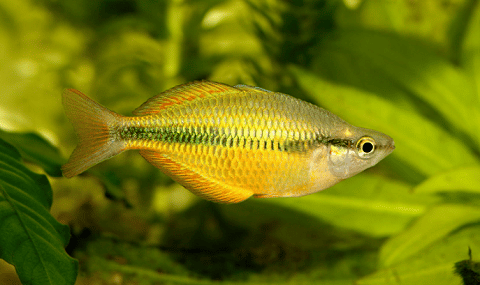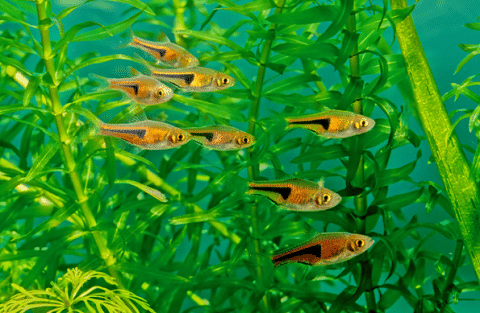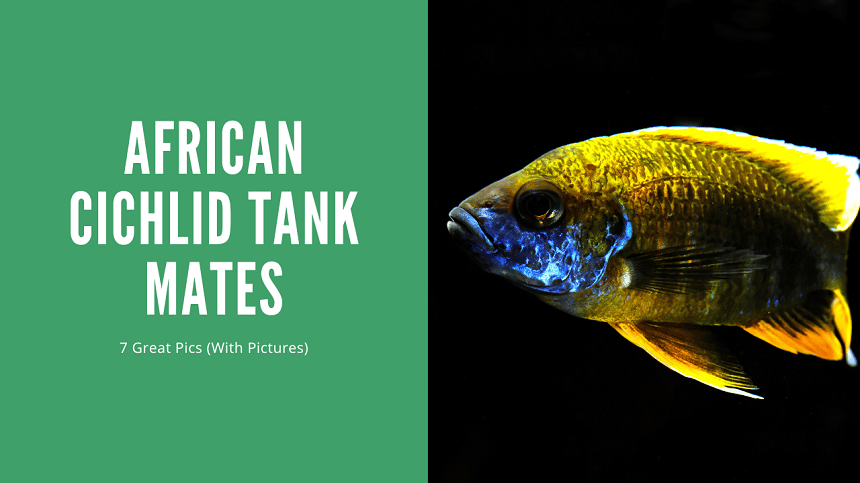Thank you for visiting! By the way… any links on this page that lead to products on Amazon and other stores/partners are affiliate links Aquarium Store Depot earns a commission if you make a purchase.
Are you looking to add some variety and ‘oomph’ to your African cichlid tank? With the right companions, an African cichlid tank can provide a vibrant display of unique colors, life-like behavior, and fun interactions. Check out the top 7 ideal African Cichlid tank mates ―all of which are sure to make any fish enthusiast smile! Each companion has been researched and vetted in order to ensure that they fit well with African cichlids while taking into account their specific needs so that you have peace of mind knowing your fish will have a safe environment in which to thrive.
Key Takeaways
- African cichlids are aggressive fish that need to be kept in water parameters that resemble those in their natural habitat.
- Not many species can be kept in the same tank as African cichlids due to their extreme aggression and preferred water conditions. Even closely related species of African cichlid might cause problems with each other.
- There are a few limited species that can safely be kept with African cichlids as tank mates.
Introduction To African Cichlids
When deciding what kind of fish to keep in your freshwater aquarium, you’ll be forced to choose between a community tank or an aggressive one. Those who don’t choose to go with community oftentimes find themselves with an impressive African cichlid setup.
It’s no wonder why African cichlids aquariums are so popular. These fish are big and beautiful and have interesting behaviors. Though they require a bigger tank than their community counterparts, their care requirements are relatively easy and straightforward.
African cichlids originate from some of the oldest freshwater lakes in the world, including Lake Tanganyika, Lake Malawi, and Lake Victoria. Many of the species in these African lakes have undergone divergent evolution over millions of years. This implies that one common ancestor evolved and adapted to different depths, parameters, and conditions within these ecosystems to create new species.
There are thought to be as many as 2,500 known members of the Cichlidae family around the world, with many unnamed and yet to be discovered.
Stocking A Tank
With so many species to choose from, it’s no wonder that the African cichlid quickly made its way into the home aquarium hobby.

One of the most common African cichlid setups is a 55-gallon tank featuring several lake species or a variety of one species. This tank should have good filtration as these fish can grow to a reasonable size. Decoration should be minimal yet sturdy, as cichlids are notorious for rearranging their environments; natural rocks, driftwood, and clay pots are preferred for shelter.
Most hobbyists use a bare bottom or crushed coral substrate that helps boost pH levels. African cichlids originate from hard, basic water parameters that need to be replicated in the home aquarium. Many hobbyists achieve this through a calcium carbonate substrate, though pH-boosting powders and liquids are regularly used as well.
Once the tank has been set up and cycled, it’s time to start thinking about which species you want to keep in the tank. While many cichlid enthusiasts only keep different types of cichlid in their tanks, others attempt to keep other fish species altogether.
There are a few things to keep in mind when keeping either other cichlid tank mates or other species, like tank size, water parameters, and aggression.
Things To Consider
It’s important to ask the question of if and why you want to keep species other than African cichlids. These are beautiful, active fish that naturally provide variety and excitement. Introducing other species is always a risk due to the natural aggression of cichlids.
Cichlids are large, aggressive fish that need adequate swimming space and ground to claim territory. The bare minimum tank size recommended for a cichlid tank is 55 gallons, with a 75-gallon tank setup providing much more comfortable space. Based on the size and aggression of individual fish, this may or may not be enough buffering to keep fish safe from one another, which could limit the number of potential tank mates.
If planning to keep tank mates outside the Cichlidae family, it’s recommended to have an aquarium that is at least 125 gallons. As we’ll see, many potential cichlid tank mates grow to extreme sizes on their own, requiring a larger tank.
It’s also important to consider the natural habitat of African cichlids. Though they come from isolated ecosystems, conditions change across different regions of the given lake. In general, African cichlids prefer hard, basic water parameters. This is in contrast to most another freshwater tropical fish that originate from soft, acidic conditions.
Lastly, aggression will determine which tank mates do and do not work. This is true for the demeanor of the individual cichlid and given tank mate.
The Best Tank Mates
Though African cichlids are regularly kept in cichlid-only tanks, there are a few options once tank size, water conditions, and aggression levels have been matched. Even if you choose to keep only African cichlids, there are still a few considerations when putting different species together.
We have a video below from our YouTube channel. We go over more detail in our blog post below. If you like our content, make sure to subscribe. We post new videos every week!
Here are some of the best tank mate options available for African cichlids tank setups!
1. Other Types
The best tank mates for African cichlids are other African cichlids. However, there are some hard rules that need to be considered when mixing these fish.

African cichlids originate from massive lakes where varieties of the same species might not ever interact. Now take into consideration the differences in appearance and behavior between entire species found at separate ends of the given lake. There are simply too many differences between African cichlids to say they are all compatible.
The key differences between these fish are size, activity, and aggression. Some fish stay relatively still while others zoom around the tank. Though all cichlids have an aggressive nature, some actively seek out fights while others wait to defend their territories.
There are many species of African cichlids (and many more yet to be discovered). Some of the most popular ones are from the following genera:
- Melanochromis
- Pseudotropheus
- Aulonocara
- Neolamprologus
- Sciaenochromis
- Haplochromis
- Cyphotilapia
It is very common to keep species-only tanks featuring peacock cichlids (Aulonocara spp.), hap cichlids (Haplochromis), or Mbuna cichlids which is a general group of cichlids from Lake Malawi. Other hobbyists pick specific regions of African lakes and stock according to the endemic species of that area.
There are many combinations that do and do not work. Some tried, and true tank mate pairings don’t work because of an especially aggressive fish. Tank mates should be researched thoroughly and added together for the best chances of success. It also helps to pick fish that are generally the same size and different colors.
How Many Should You Keep Together?
African cichlids are big fish that need space. How many cichlids you can keep per tank will vary, especially if keeping other fish species. However, a typical 55-gallon cichlid aquarium setup can hold about 10 to 15 cichlids.
2. Jewel Cichlid

- Scientific name: Hemichromis bimaculatus
- Temperament: Semi-aggressive
- Origin: Western Africa
- Size: 6 inches
- Minimum Tank Size: 75 gallons
- Diet: Omnivore
- pH: 7.0-8.0
- Temperature: 75-82°F
The jewel cichlid is one of the most attractive African cichlids available. These fish are bright red with small, iridescent blue flecks.
Though jewel cichlids are a type of African cichlid, they’re not compatible with most other endemic species. This is because these otherwise semi-aggressive fish turn into overly aggressive fish whenever they spawn. Jewel cichlids have known fin nippers and will fight to the death to defend their young.
There is some debate about whether or not jewel cichlids should be kept with other cichlids. There is a lot that can and has gone wrong. However, hobbyists have found success keeping jewel cichlids in the same tank with more aggressive African cichlids, like Mbuna species.
3. Paratilapia polleni
- Scientific name: Paratilapia polleni
- Temperament: Aggressive to smaller fish
- Origin: Madagascar
- Size: 12 inches
- Minimum Tank Size: 75 gallons
- Diet: Omnivore (naturally a piscivore)
- pH: 6.5-8.0
- Temperature: 75-82°F
Sometimes called the starry night cichlid (video source), Paratilapia polleni is a relatively peaceful species of East African cichlid. These speckled near-black fish are endangered and the last remaining species of their genus. This can make them relatively difficult and expensive to obtain in the hobby.
Paratilapia polleni are large fish that are mainly piscivores in the wild, meaning that most of their diet is made up of smaller fish. The problem is that these African cichlids can grow to be a foot in length, leaving many fish to be smaller than them. As long as tank mates can’t easily fit into the mouth of your Paratilapia polleni, there shouldn’t be too many problems keeping them with other African cichlids.
4. Synodontis Catfish

- Scientific name: Synodontis spp.
- Temperament: Peaceful
- Origin: Africa
- Size: Varies
- Minimum Tank Size: 55 gallons
- Diet: Omnivore
- pH: 7.5-9.0
- Temperature: 75-82°F
Cichlids aren’t the only fish present in African lakes. Synodontis catfish are found in central and west African ecosystems, with notable populations in Lake Tanganyika and Lake Malawi. Some popular species for the cichlid aquarium include:
- Cuckoo catfish (Synodontis multipunctatus)
- Dwarf Lake/False cuckoo Synodontis (Synodontis petricola)
- Malawi squeaker (Synodontis njassae)
These catfish are ideal as they come from the same ecosystems as cichlids, but at different depths; Synodontis catfish live on the bottom while cichlids stay higher up in the water column. In the aquarium, these fish need to be given plenty of hiding places. They also prefer to be in small shoals or at least 3 or 4.
5. Rainbowfish

- Scientific name: Melanotaenia spp.
- Temperament: Peaceful
- Origin: Australia and New Guinea
- Size: 4-5 inches
- Minimum Tank Size: 55 gallons
- Diet: Omnivore
- pH: 7.0-8.0
- Temperature: 75-82°F
An unlikely pairing, rainbowfish and African cichlids have been known to live harmoniously together. Rainbowfish are large and fast yet peaceful fish that can easily outmaneuver or intimidate a cichlid when in a school with others.
Their size, speed, and tolerance to more basic water conditions make rainbowfish a great potential tank mate for African cichlids. Rainbowfish can be thought of as a dither fish species for cichlids as they lessen aggression and encourage natural behavior.
Not all rainbowfish can be tank mates for African cichlids, though. Boeseman’s rainbowfish (Melanotaenia boesemani) is the best species to pick.
6. Pleco Fish

- Scientific name: Hypostomus spp., Ancistrus spp.
- Temperament: Peaceful
- Origin: South America
- Size: Varies
- Minimum Tank Size: 125 gallons
- Diet: Omnivore
- pH: 7.0-8.0
- Temperature: 75-82°F
Pleco species aren’t usually recommended for aquarium use, but they tend to make perfect tank mate options for a cichlid aquarium. These South American fish have been bred in the aquarium to endure various water parameters, including those harder and more basic ones preferred by African cichlids.
Plecos are armored fish that spend most of their time hidden under rocks and branches on the substrate floor. While these fish have excellent camouflage, chosen plecos should still be several inches in length to be able to defend themselves from especially aggressive cichlids.
Common plecos kept in cichlid tank setups include the common pleco (Hypostomus plecostomus) and some bristlenose species (Ancistrus spp.).
7. Red Tail Shark

- Scientific name: Epalzeorhynchos bicolor
- Temperament: Semi-aggressive to aggressive
- Origin: Thailand
- Size: 4 inches
- Minimum Tank Size: 55 gallons
- Diet: Omnivore
- pH: 6.5-7.5
- Temperature: 75-82°F
The red-tail shark is a problematic fish within the tropical community fish hobby. They are often misidentified as calmer and more peaceful rainbow sharks (Epalzeorhynchos frenatum), leaving unknowing hobbyists with very aggressive fish as they can be incompatible tank mates.
Red-tail sharks are small and fast. They can easily find coverage in a sheltered area from a predator, though they’re very likely to try to fight back. These freshwater sharks are extremely territorial and have successfully been kept with some of the less aggressive species of an African cichlid.
The problem is that redtail sharks can’t tolerate a high pH level. The red tail shark originates from detritus-rich freshwater rivers and streams in Southeast Asia, which is a very different environment from that of African cichlid species. To make these two work as tank mates, the pH must stay at the upper range for the red-tail shark and the lower range for the African cichlid at about 7.5.
Fish To Avoid
Unfortunately, there are more fish that can’t be added to African cichlid tanks than there are good tank mates. Many fish available in the hobby can’t tolerate the hard and basic water that African cichlids need. On top of that, cichlids try to kill almost every small and docile fish that comes near them. Both these factors considered leaves very few tank mate options available.
Still, some fish species should be avoided entirely.
Most Community Freshwater Fish
As mentioned before, most community freshwater fish are incompatible with African cichlid species. This is largely due to differences in preferred water parameters and aggression levels.

Most freshwater fish originate from South America or Southeast Asia where water is very soft and acidic. This is very different from the higher hardness and pH levels preferred by African cichlids.
A freshwater fish tank is also set up much differently than one meant for cichlids. Freshwater fish love plenty of hiding spots with natural decor like live plants. While cichlids come from a very open and rocky terrain, freshwater fish like to hide in and around vegetation.
Lastly, many freshwater fish have peaceful demeanors. They rely on schooling behaviors to keep them safe from predators instead of being actively aggressive. Cichlids establish territories they will defend to death, especially during spawning periods, and won’t hesitate to attack and kill other fish.
Goldfish
Goldfish cannot be kept with any tropical fish, including African cichlids. Goldfish are coldwater fish with very exact and limited tank mates due to their preference for low temperatures and their high waste output. On top of that, many fancy goldfish are poor swimmers that would easily get beat up by an African cichlid.
Koi
For the same reasons why goldfish can’t be African cichlid tank mates, koi should also be avoided. Koi are coldwater fish that need low temperatures and good filtration due to their high waste output. Due to their size and activity level, they are best kept in pond settings.
Corydoras Catfish
Corydoras catfish might seem like a good tank mate option for African cichlids due to their speed and safety in numbers as bottom feeders, but they are not. Corydoras largely originate from blackwater ecosystems throughout South America. In addition to their preference for softer and acid water, they also prefer lower water temperatures which are incompatible with cichlids.
Corydoras also stay relatively small, making them easy to eat for larger fish despite being kept in big schools.
American Cichlids
While many cichlids are native to Africa, an entirely different selection of fish is available from South America, including Central America. Some of these fish include members of the Mikrogeophagus, Apistogramma, and Symphysodon genera.
Many South American cichlids, especially dwarf cichlids, can be kept with freshwater community species due to their generally peaceful demeanors. This is in direct contrast to African cichlids’ aggressive and incompatible temperament. As species from South America, these fish also prefer different water parameters from their African counterparts.
While it is usually a hard no to keep African and South American cichlids together, hobbyists have succeeded in keeping some species together. This should only be attempted by expert cichlid-keepers.
Can You Mix in Angelfish?
Did you know that freshwater angelfish (Pterophyllum scalare) are a type of cichlid? These fish don’t look like any other cichlid species and have a very calm demeanor in comparison, but they’re a type of South American cichlid.
Angelfish are moderately difficult fish to keep due to their long fins and slow movement. Even community fish tanks struggle to find compatible tank mates. That being said, African cichlids are not good tank mates for angelfish due to their large difference in behaviors and temperaments. However, some hobbyists have had success keeping angelfish with other South American cichlids.
Final Thoughts
African cichlids are large, beautiful fish that can quickly fill up an aquarium. The problem is that not many suitable tank mates can be safely kept with them, deterring some hobbyists from keeping a species-only setup. Even then, some African cichlids have problems with each other, which can lead to gruesome death.
Luckily, several species have been found to be good tank mates for African cichlids. Long-term success will largely depend on the individual personalities of the fish, though.
- About the Author
- Latest Posts
I’m thrilled that you found Aquarium Store Depot! Here you’ll find information on fish, aquariums, and all things aquatics related. I’m a hobbyist (being doing this since I was 11) and here to help other hobbyists thrive with their aquariums! I adhere to a high quality Editorial Process and Review products with real life field usage and practical analysis.





